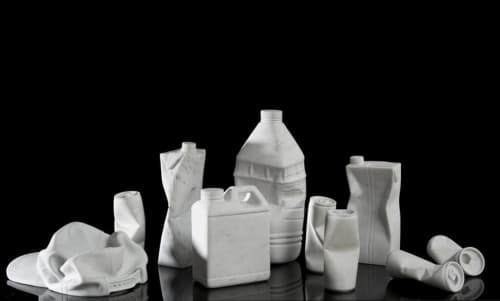When we think of marble we think of lavish interiors and classical architecture. We think of art history favourites – the Venus de Milo, Michelangelo’s David or maybe The Kiss by Rodin. We know marble as monumental.
Martin Selman’s work poses a challenge to the way we appreciate marble as a material. He takes this expensive stone that is steeped in historical connotation and makes it modern. He liberates Carrara marble from the burden of its history, and undermines tradition by his choice to craft trash from this costly rock.
Selman takes a raw, natural material born of the Earth – a material that has been considered a luxury for centuries – and creates replicas of mass-produced items. Brand-less bottles, crumpled, discarded and overlooked. A juice carton, a soft-drink can, a plastic water bottle. Items that have a very real impact on the planet and have fast become a blight of our times. To recreate these items and place them on a slick, black granite plinth encourages us to slow down and examine our use of ‘disposables’.
In considering Selman’s K-Road installationwe wonder: did Selman collect the six cans while walking K’Road and return with them to his studio, to laboriously carve them from marble? This work, along with the Lovers’ Lane installation, becomes evocative of a time and place – site specific yet removed from the site.Fossil-like, the works serve to capture the detritus of everyday life in 21st century New Zealand. They prompt us to question what we really value. The convenience of bottled water? The continued sustenance of life on Earth? Should a plastic water bottle be immortalised in marble when the bottle itself is immortal by design?
It’s difficult to look at Selman’s works and not immediately want to feel their weight, the smooth surface and the temperature cool to the touch. We know intimately how the real items feel in our hands (though we don’t give them much consideration at the time of use); to compare and contrast the marble likeness with what we know of the actual items is immediately tempting. Vessels no longer, the marble versions are functionless. Or rather, the function of the original item is denied in the replica. Label-less, they have no identifiers beyond their form alone. We are left to decipher what we know of them.
As expertly refined and carefully crafted as the ‘still life’ works, Selman’s wall-hung Geometric Abstraction in White is restful and sublime. Like great architecture, sculpture can be completed by our experience of light shifting across its form. Selman’s minimalist abstractions are beautiful to contemplate as light plays over the textured surface, creating shadows and contrast and altering the pattern as time passes.
The breadth of Selman's work demonstrates that marble has currency, credence and relevance as a medium in contemporary art practice.
Essay by Steph Chalmers
BIOGRAPHY
Born: Birmingham, United Kingdom
Lives: Auckland
Education:Bachelor of Arts, Massey University, Palmerston North; Diploma of Visual Art and Design, EIT, Hawke’s Bay
Awards/Distinctions:Tutor, Sculpture Conference, Dornach, Switzerland; Tutor, Kunst Festival, Basel, Switzerland; Hawkes Bay Cultural Trust Sculpture Award - Winner (2001)
Collections:Hastings District Council; Woodford House, Hawkes Bay; Healthcare Hawkes Bay; Waldorf Institute, Hawkes Bay
Public Exhibitions:Hawkes Bay Invitational, Hastings Exhibition Centre (2011, 2010, 2008, 2007); Shrunk, Brick Bay Sculpture Park, Auckland (2011, 2010); NZ Sculpture OnShore, Auckland (2010, 2008, 2006); Shapeshifter, The Dowse, Wellington (2010, 2008); Shapeshifter, Wellington (2006, 2004); Spellbound, Dowse Art Museum, Wellington (2004)
Articles:‘Fables, illusions and hard rock’ by Terry McNamara, The New Zealand Herald, Dec 2010; ‘The Heart of the Stone’ by Jane Warwick, BMW Magazine, 2008, Issue 3, pp 54-60
Artwork Featured in:The New Zealand Herald, Jan 2013
